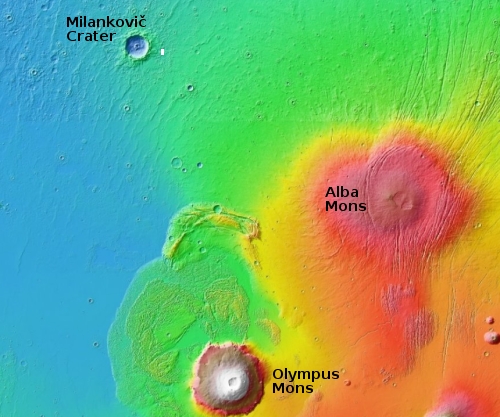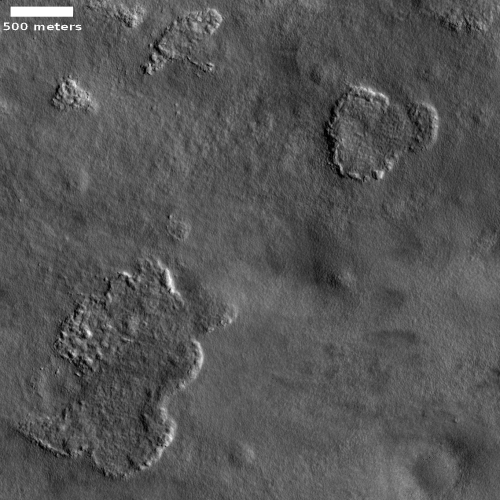The sublimating surface of Mars’ northern plains?
Cool image time! The photograph to the right, cropped and reduced to post here, was taken by the high resolution camera on Mars Reconnaissance Orbiter on May 27, 2021. A sample image, likely taken not as part of any specific scientist’s research but by the camera team in order to maintain the camera’s temperature, shows an area of the Martian northern plains that appears filled with rough scattered depressions, possibly caused by sublimation of buried ice.
The location, at 54 degrees north latitude, is far enough north to easily have a lot of buried ice. It is also only about 40 miles to the east of Milankovič Crater, where scientists have found many scarps that appear to have exposed layers of ice in their cliff faces.
However, the location has other components that must raise questions about this sublimating ice hypothesis.

The white rectangle on the overview map to the right marks the location of today’s image, sitting on the edge of the vast volcanic flood plain that descends from the shield volcano Alba Mons. The features we see in this image might also be long inactive volcanic processes, now eroding with time.
The image could also be showing us a combination of both processes, whereby Alba Mons first laid down its sheets of lava, and then over the eons of Martian climate cycles the coming and going of ice and snow acted to wear away these patches.
And even if it is correct that a combination of these two processes explains what we see, it remains a very incomplete simplification of the geology. There must be a lot more going on here, that we can not identify merely from orbital images. For example, there might be very specific materials at each patch that aides the erosion. To find out we’d need to gather samples and do chemical analysis, something that from orbit can only be done in a very limited and uncertain manner.
On Christmas Eve 1968 three Americans became the first humans to visit another world. What they did to celebrate was unexpected and profound, and will be remembered throughout all human history. Genesis: the Story of Apollo 8, Robert Zimmerman's classic history of humanity's first journey to another world, tells that story, and it is now available as both an ebook and an audiobook, both with a foreword by Valerie Anders and a new introduction by Robert Zimmerman.
The print edition can be purchased at Amazon or from any other book seller. If you want an autographed copy the price is $60 for the hardback and $45 for the paperback, plus $8 shipping for each. Go here for purchasing details. The ebook is available everywhere for $5.99 (before discount) at amazon, or direct from my ebook publisher, ebookit. If you buy it from ebookit you don't support the big tech companies and the author gets a bigger cut much sooner.
The audiobook is also available at all these vendors, and is also free with a 30-day trial membership to Audible.
"Not simply about one mission, [Genesis] is also the history of America's quest for the moon... Zimmerman has done a masterful job of tying disparate events together into a solid account of one of America's greatest human triumphs."--San Antonio Express-News
Cool image time! The photograph to the right, cropped and reduced to post here, was taken by the high resolution camera on Mars Reconnaissance Orbiter on May 27, 2021. A sample image, likely taken not as part of any specific scientist’s research but by the camera team in order to maintain the camera’s temperature, shows an area of the Martian northern plains that appears filled with rough scattered depressions, possibly caused by sublimation of buried ice.
The location, at 54 degrees north latitude, is far enough north to easily have a lot of buried ice. It is also only about 40 miles to the east of Milankovič Crater, where scientists have found many scarps that appear to have exposed layers of ice in their cliff faces.
However, the location has other components that must raise questions about this sublimating ice hypothesis.

The white rectangle on the overview map to the right marks the location of today’s image, sitting on the edge of the vast volcanic flood plain that descends from the shield volcano Alba Mons. The features we see in this image might also be long inactive volcanic processes, now eroding with time.
The image could also be showing us a combination of both processes, whereby Alba Mons first laid down its sheets of lava, and then over the eons of Martian climate cycles the coming and going of ice and snow acted to wear away these patches.
And even if it is correct that a combination of these two processes explains what we see, it remains a very incomplete simplification of the geology. There must be a lot more going on here, that we can not identify merely from orbital images. For example, there might be very specific materials at each patch that aides the erosion. To find out we’d need to gather samples and do chemical analysis, something that from orbit can only be done in a very limited and uncertain manner.
On Christmas Eve 1968 three Americans became the first humans to visit another world. What they did to celebrate was unexpected and profound, and will be remembered throughout all human history. Genesis: the Story of Apollo 8, Robert Zimmerman's classic history of humanity's first journey to another world, tells that story, and it is now available as both an ebook and an audiobook, both with a foreword by Valerie Anders and a new introduction by Robert Zimmerman.
The print edition can be purchased at Amazon or from any other book seller. If you want an autographed copy the price is $60 for the hardback and $45 for the paperback, plus $8 shipping for each. Go here for purchasing details. The ebook is available everywhere for $5.99 (before discount) at amazon, or direct from my ebook publisher, ebookit. If you buy it from ebookit you don't support the big tech companies and the author gets a bigger cut much sooner.
The audiobook is also available at all these vendors, and is also free with a 30-day trial membership to Audible.
"Not simply about one mission, [Genesis] is also the history of America's quest for the moon... Zimmerman has done a masterful job of tying disparate events together into a solid account of one of America's greatest human triumphs."--San Antonio Express-News


